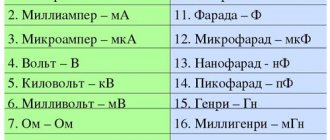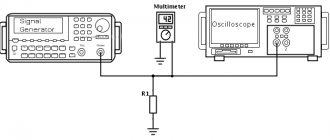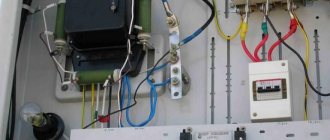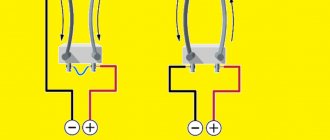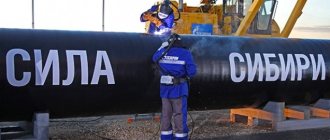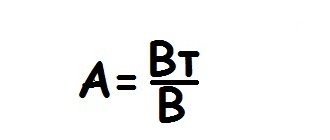Horsepower is a non-systemic unit of measurement of a power parameter. In fact, all over the world several different units are called “horsepower”. In the Russian Federation, the term “horsepower” usually means “metric” horsepower. s., which is equivalent to 735.49875 W.
Now in the Russian Federation this unit has been formally withdrawn from use, but today it is used to calculate the amounts of transport taxes, as well as compulsory motor liability insurance. The SI system long ago established the watt as its official unit.
The English system of measurement recognizes lb-ft/sec as a unit of power, but in reality this unit is no longer used in the UK, and is used extremely rarely in the USA.
What is horsepower and how did it come about?
For what reason did horsepower come into use as a unit of power? How is it expressed through other units? J. Watt proposed in the 18th century. device for pumping water out of mines. However, it was necessary to somehow explain to the mine owners what exactly he was offering them to buy, what the advantages of the invention were.
To evaluate the power of the new engine, such an event was undertaken. The horse was harnessed to an ordinary pump to raise water, which worked using horse traction. Then they estimated exactly how much water the horse would lift in 1 day.
Then they connected a steam engine to this pump and saw the result obtained within 1 day of operation. The 2nd number was divided by the 1st, using these numbers to explain to the mine owners that the pump could replace so many horses. The power value obtained as a result of the first experiment was made a yardstick, denoting it with the phrase “horsepower”.
Thus, the wording “horsepower” appeared thanks to the official inventor of the steam engine, engineer J. Watt from England. He had to make a clear demonstration of the fact that the machine he created could become a replacement for many horses. To do this, it would be necessary to somehow define in units the work that a horse is capable of performing in a certain time.
Having carried out his observations in coal mines, Watt demonstrated the ability of the average horse to lift loads weighing approximately 75 kg from a mine at a speed of 1 m/s .
1 l. With. - a unit of power, not force. Metric l. With. equal to 0.736 kW.
How to use an online calculator
Converting kilowatts to horsepower using a calculator is done as follows:
- At the top left , select metric units - watts or kilowatts.
- From below, select the type of “horses” - metric, English or electric (in practice, metric ones are most often used).
- At the top, enter the number in the appropriate cell: if you need to convert kW to hp, enter the number in the left cell, if vice versa, enter the number in the right cell.
- To enter fractional numbers, use the comma (“,”) separator character.
What are kilowatts (kW)
Watt is the SI unit of power, named after the inventor J. Watt, who created the universal steam engine. The watt was adopted as a unit of power during the 2nd Congress of the Scientific Association of Great Britain in 1889. Previously, horsepower, which was introduced by J. Watt, was mainly used for calculations, less often - foot-pounds/min. The 19th General Conference of Measures in 1960 decided to include Watt in the SI.
One of the main parameters of any electrical device is the power it consumes. For this reason, on each electrical device (or in the instructions supplied with it) you can read data on the number of watts that are required for the operation of the device.
1 Watt is a unit of power that allows you to perform 1 J of work within 1 second.
It is not just mechanical power that is distinguished. Thermal and electrical power are also known. 1 Watt of heat flow is equivalent to 1 Watt of mechanical power. 1 Watt for electrical power is equivalent to 1 Watt for mechanical power and is essentially the power of a direct electric current of 1 A, which does work at a voltage of 1 V.
Basic units of engine power and their designation
1. Horsepower (735.49875 W). Denoted as: hp (this is netto engine power, measured using engine auxiliary units, such as muffler, generator), bhp (this is gross engine power, measured without the use of additional units).
You can also find other designations: PS (German), CV (French), pk (Nid.).
In English-speaking countries, horsepower is still more often equated to 745.6999 W, which is approximately equal to 1.014 European horsepower.
2. Watt
Since the description of the watt is beyond the scope of this article, we will not touch on it here.
Table for translation l. With. in kW
To calculate the motor power in kW, you need to use the proportion 1 kW = 1.3596 hp. With . Its reverse form: 1 l. With. = 0.73549875 kW. This is how these two units are mutually converted into each other.
| kW | hp | kW | hp | kW | hp | kW | hp | kW | hp | kW | hp | kW | hp |
| 1 | 1.36 | 30 | 40.79 | 58 | 78.86 | 87 | 118.29 | 115 | 156.36 | 143 | 194.43 | 171 | 232.50 |
| 2 | 2.72 | 31 | 42.15 | 59 | 80.22 | 88 | 119.65 | 116 | 157.72 | 144 | 195.79 | 172 | 233.86 |
| 3 | 4.08 | 32 | 43.51 | 60 | 81.58 | 89 | 121.01 | 117 | 160.44 | 145 | 197.15 | 173 | 235.21 |
| 4 | 5.44 | 33 | 44.87 | 61 | 82.94 | 90 | 122.37 | 118 | 160.44 | 146 | 198.50 | 174 | 236.57 |
| 5 | 6.80 | 34 | 46.23 | 62 | 84.30 | 91 | 123.73 | 119 | 161.79 | 147 | 199.86 | 175 | 237.93 |
| 6 | 8.16 | 35 | 47.59 | 63 | 85.66 | 92 | 125.09 | 120 | 163.15 | 148 | 201.22 | 176 | 239.29 |
| 7 | 9.52 | 36 | 48.95 | 64 | 87.02 | 93 | 126.44 | 121 | 164.51 | 149 | 202.58 | 177 | 240.65 |
| 8 | 10.88 | 37 | 50.31 | 65 | 88.38 | 94 | 127.80 | 122 | 165.87 | 150 | 203.94 | 178 | 242.01 |
| 9 | 12.24 | 38 | 51.67 | 66 | 89.79 | 95 | 129.16 | 123 | 167.23 | 151 | 205.30 | 179 | 243.37 |
| 10 | 13.60 | 39 | 53.03 | 67 | 91.09 | 96 | 130.52 | 124 | 168.59 | 152 | 206.66 | 180 | 144.73 |
| 11 | 14.96 | 40 | 54.38 | 68 | 92.45 | 97 | 131.88 | 125 | 169.95 | 153 | 208.02 | 181 | 246.09 |
| 12 | 16.32 | 41 | 55.74 | 69 | 93.81 | 98 | 133.24 | 126 | 171.31 | 154 | 209.38 | 182 | 247.45 |
| 13 | 17.67 | 42 | 57.10 | 70 | 95.17 | 99 | 134.60 | 127 | 172.67 | 155 | 210.74 | 183 | 248.81 |
| 14 | 19.03 | 43 | 58.46 | 71 | 96.53 | 100 | 135.96 | 128 | 174.03 | 156 | 212.10 | 184 | 250.17 |
| 15 | 20.39 | 44 | 59.82 | 72 | 97.89 | 101 | 137.32 | 129 | 175.39 | 157 | 213.46 | 185 | 251.53 |
| 16 | 21.75 | 45 | 61.18 | 73 | 99.25 | 102 | 138.68 | 130 | 176.75 | 158 | 214.82 | 186 | 252.89 |
| 17 | 23.9 | 46 | 62.54 | 74 | 100.61 | 103 | 140.04 | 131 | 178.9 | 159 | 216.18 | 187 | 254.25 |
| 18 | 24.47 | 47 | 63.90 | 75 | 101.97 | 104 | 141.40 | 132 | 179.42 | 160 | 217.54 | 188 | 255.61 |
| 19 | 25.83 | 48 | 65.26 | 76 | 103.33 | 105 | 142.76 | 133 | 180.83 | 161 | 218.90 | 189 | 256.97 |
| 20 | 27.19 | 49 | 66.62 | 78 | 106.05 | 106 | 144.12 | 134 | 182.19 | 162 | 220.26 | 190 | 258.33 |
| 21 | 28.55 | 50 | 67.98 | 79 | 107.41 | 107 | 145.48 | 135 | 183.55 | 163 | 221.62 | 191 | 259.69 |
| 22 | 29.91 | 51 | 69.34 | 80 | 108.77 | 108 | 146.84 | 136 | 184.91 | 164 | 222.98 | 192 | 261.05 |
| 23 | 31.27 | 52 | 70.70 | 81 | 110.13 | 109 | 148.20 | 137 | 186.27 | 165 | 224.34 | 193 | 262.41 |
| 24 | 32.63 | 53 | 72.06 | 82 | 111.49 | 110 | 149.56 | 138 | 187.63 | 166 | 225.70 | 194 | 263.77 |
| 25 | 33.99 | 54 | 73.42 | 83 | 112.85 | 111 | 150.92 | 139 | 188.99 | 167 | 227.06 | 195 | 265.13 |
| 26 | 35.35 | 55 | 74.78 | 84 | 114.21 | 112 | 152.28 | 140 | 190.35 | 168 | 228.42 | 196 | 266.49 |
| 27 | 36.71 | 56 | 76.14 | 85 | 115.57 | 113 | 153.64 | 141 | 191.71 | 169 | 229.78 | 197 | 267.85 |
| 28 | 38.07 | 57 | 77.50 | 86 | 116.93 | 114 | 155.00 | 142 | 193.07 | 170 | 231.14 | 198 | 269.56 |
Scale giving an approximate idea of the engine power range
To get an idea of the power range of the engines, please refer to the following figure:
- 0-100 l. With. — small cars;
- 100-200 l. With. - cars with medium power engines;
- 200-500 l. With. — sports cars;
- 500 l. With. and more - racing cars and supercars.
How is engine power measured?
In practice, watts/kilowatts are most often used, and horses are used only in one area - calculating the power of a car engine. The thing is that in Russia almost all car owners are required to pay a transport tax, and its size directly depends on the number of “horses” of the engine.
Let's consider when you need to use one or another horse for calculations:
- Metrics are the basic units for measuring engine power, as they are the most commonly used in practice.
- English - used to calculate the power of cars that are manufactured in some English, American, Canadian, Australian and New Zealand factories.
- Electric – needed to calculate the power of a car with an electric and combined engine.
Instruments for measuring engine power
For the calculation, a special device called a dynamometer is used, which is connected directly to the car engine. To determine the strength of the engine, the car is placed on a special platform, and then the engine is idled with a connected dynamometer. Based on the measurement of certain technical indicators (acceleration, acceleration speed, stability, and others), during acceleration, the dynamometer determines the total power, and the results are displayed on a digital or analog screen.
Let's look at how they differ and which of these indicators is more reliable:
- Gross power - this indicator is measured when accelerating a “naked” car (that is, without a muffler, secondary shock absorbers and other auxiliary parts).
- Net power - this indicator is measured when accelerating a “loaded” car, taking into account all the necessary parts that are needed for a comfortable ride.
Please note that when determining transport tax, it is necessary to determine exactly the “loaded” net power. The thing is that gross power is usually 10-20% higher than the net figure (after all, the car does not have to “accelerate” additional important parts in this case)
This trick is often used by unscrupulous manufacturers and marketers who want to present their car in a better light, which must be remembered when taking measurements.
What is horsepower
The unit of measurement for drugs was invented by James Watt at the end of the 18th century. It is assumed that this name is due to the fact that Watt wanted to prove the superiority of his steam engines over the more traditional draft labor force - over horses. A popular legend says that after the creation of the first prototypes, one of the steam engines was bought by a local brewer who needed the engine to operate a water pump. During the test, the brewer compared the steam engine with his strongest horse - and it turned out that the horse was 1.38 times weaker than the steam engine (and 1 kilowatt is exactly 1.38 hp).
What are kilowatts
At the beginning of the 19th century, horsepower began to be used to refer to the maximum power that one strong horse could produce. However, some engineers and scientists began to use not abstract horses as a starting point, but rather the very concrete first Watt machines of fixed power. This practice took hold at the end of the 19th century, when watts were recognized as a unit of power. However, not all states recognized the new units, so today horsepower is still used as an auxiliary or main unit of power.
FAQ
How many kilowatts are in one horsepower?
One metric horsepower is equal to 0.735 kilowatts (745.7 watts) when calculating engine power in kilowatts. How many kW are in 1 hp? calculated using the formula: power in kilowatts divided by a factor of 1.36.
How many hp in kW?
To convert horsepower to the kilowatt unit, you need to multiply its value by 0.735.
How much is 5 hp in kW?
According to metric calculus, where the ratio of 1kW is equal to 1.359 hp. - 5 horsepower is approximately equal to 3.68 kilowatts of power. If the calculation is carried out with an electric motor, then 5 hp will be 3.73 kW, because When operating an electric motor, the ratio should be used, where 1 kW = 1.34048 hp.
Power indicator - watt
The designation for horsepower is different in different languages, for example:
- l. With. - in Russian;
- hp - in English;
- PS – in German;
- CV - in French.
Power P, as a system unit, is measured in SI in watts (W, W). This is 1 Joule (J) of work that can be done in 1 second.
Electrical machines, thermal appliances, current and voltage sources are designated P in kilowatts (kW, kw). Since watt is a small value, its multiple value of 1*103 is used. This measure was introduced into the designation in honor of the same James Watt. It measures both the power supplied by the energy source and consumed by consumers. The latter is also called power consumption. Its values are applied to the bodies of devices and household appliances.
In order to calculate the amount of energy required to ensure the operation of all devices connected to a 220 V network, you need to add up all power consumption.
Formula for determining electrical power:
P = I*U,
Where:
- P – power, W;
- I – current, A;
- U – voltage, V.
This formula for determining power is correct for direct current. When calculating for alternating current, take into account the values of cosϕ, which practically lies in the range from 0.5 to 0.7. This is the phase shift coefficient between current and voltage.
Despite the fact that it is universally forbidden to indicate the value of P in horsepower without indicating it next to it in watts, this can be encountered. Knowing the ratio and methods of translating l will help you not to get confused in this. With. to kW and back.
Maximum speed:
A diesel engine is not a constant value, since this value depends on engine speed. To achieve maximum speed, the maximum strength of these parameters is necessary:
As an example, let's take a unit with a capacity of 150 horsepower. This internal combustion engine value can only be achieved at 6000 rpm.
When reaching 1500-3000 rpm, the number of “horses” decreases significantly. Therefore, to achieve maximum power, be sure to continuously press the accelerator pedal. The need to downshift to ensure efficient dynamics is explained by this.
To determine the power of the car, you need to make some calculations:
“Power is the energy generated by the engine, it is converted into torque on the output shaft of the internal combustion engine”
As a rule, progressive engines produce power in the amount of 5500-6500 rpm. As mentioned earlier, engine power is measured in horsepower. This means that most of the results need to be converted into kilowatts, for this there are special conversion calculators. (kW to hp)
For the simplest calculation of machine engine power, you need to determine or know the relationship between torque and revolutions. Engine torque is the product of force and the arm of the lever to which it is applied. Force is measured in Newtons, but lever arm is measured in meters - Nm.
To calculate torque from engine volume, there is a special formula:
P = Mkr * n/9549 [kW]
The essence of which:
- Mcr – engine torque (Nm),
- N – crankshaft speed (rpm),
- 9549 – coefficient so that the revolutions are substituted in rpm, and not in alpha cosines
How to check battery capacity?
Very often, the owner of a used battery is faced with the task of determining its residual capacity. The classic and, to our credit, the most reliable and effective way to check the actual capacity of a battery is considered to be a test discharge. This term refers to the following procedure. The battery is first fully charged, after which it is discharged with direct current, and the time during which it is completely discharged is measured. After this, the battery capacity is calculated using the already known formula:
Q=I·T
For greater calculation accuracy, it is better to select the value of the constant discharge current so that the discharge time is about 10 or 20 hours (this depends on the discharge time at which the nominal battery capacity was calculated by the manufacturer). Then the obtained data is compared with the passport data, and if the residual capacity is 70-80% less than the nominal capacity, the battery must be replaced, since this is a clear sign of severe wear of the battery and its further wear will occur at an accelerated pace.
The main disadvantages of this method are the complexity and labor-intensive implementation, as well as the need to remove batteries from service for a fairly long period of time. Today, most devices that use rechargeable batteries for their operation have a self-diagnosis function - a quick (in just a couple of seconds) check of the condition and performance of energy sources, but the accuracy of such measurements is not always high.
Practical aspect
The amount of transport tax in Russia depends on engine power. In this case, the unit of account is taken as l. pp.: the tax rate is multiplied by their number. The number of payment categories depends on the region. For example, in Moscow there are 8 categories for passenger cars (prices are valid for 2018):
- up to 100 l. With. = 12 rub.;
- 101-125 l. With. = 25 rub.;
- 126-150 l. With. = 35 rub.;
- 151-175 l. With. = 45 rub.;
- 176-200 l. With. = 50 rub.;
- 201-225 l. With. = 65 rub.;
- 226-250 l. With. = 75 rub.;
- from 251 l. With. = 150 rub.
The price is given for 1 liter. With. Accordingly, with a power of 132 hp. With. the car owner will pay 132 x 35 = 4620 rubles. in year.
Previously, in the UK, France, Belgium, Spain, and Germany, vehicle tax depended on the number of “horses”. With the introduction of the kilowatt, some countries (France) abandoned l. With. completely in favor of the new universal unit, in others (Great Britain) the size of the car began to be taken into account as the basis of the transport tax. In the Russian Federation, the tradition of using the old unit of measurement is still observed.
In addition to calculating transport tax, in Russia this unit is used in motor vehicle liability insurance (MTPL): when calculating premiums for compulsory insurance of vehicle owners.
Another practical application, now of a technical nature, is calculating the actual power of a car engine. When measuring, the terms gross and net are used. Gross measurements are carried out on a stand without taking into account the operation of related systems - generator, cooling system pump, etc. The gross value is always higher, but does not show the power produced under normal conditions. If the kilowatts indicated in the documents are converted into l. With. In this way, only the amount of engine work can be estimated.
For an accurate assessment of the power of the mechanism, this is impractical, since the error will be 10-25%. In this case, the actual performance of the engine will be overestimated, and when calculating transport tax and compulsory motor liability insurance, prices will be increased, since each unit of power is paid for.
Net measurement on a bench is aimed at analyzing the operation of the machine under normal conditions, with all auxiliary systems. The net value is smaller, but more accurately reflects the power under normal conditions with all systems operating.
A dynamometer, a device connected to the engine, will help you measure power more accurately. It places a load on the engine and measures the amount of energy delivered by the engine against the load. Some car services offer the use of dynos for such measurements.
You can also measure the power yourself, but with some error. By connecting a laptop to the car with a cable and launching a special application, you can record the engine power in kW or hp. at different speeds. The advantage of this option is that the program will display the calculation error immediately after the control assessment, and will also immediately convert from kilowatts to horsepower if the measurement was carried out in SI units.
Non-system units of measurement are gradually becoming a thing of the past. Power values are increasingly specified in watts. However, as long as horsepower is used, there will be a need to convert it.
Horsepower in a car
The value in kW divided by 0.735 is the horsepower in the car. It is comparable to the action performed in 1 s in order to lift a 75 kg load by 1 m. At the same time, gravity is also taken into account.
The greater the power of a car engine in relation to the weight of the vehicle, the more efficient it is. In other words, the less the body weighs, the greater the power indicator and the greater the acceleration of the car.
In order to transform the rated power of a certain car from kilowatts into horsepower, you need to divide the existing value by 0.735
For example, the Jeep Wrangler has 177 hp. and a total weight of 2.505 tons. The ratio of power to total weight will be: 177: 2505 = 70.56. Acceleration to hundreds of kilometers per hour - 10.1 s.
If you take a powerful Ferrari 355 F1 car with a 375 hp engine. and weighing 2.9 tons, then the ratio will be 375: 2900 = 0.129. Acceleration to 100 km/h is 4.6 seconds.
This is a table with which you can very easily transform horsepower into kilowatts without any calculations
The designation for horsepower varies from country to country. While in Russia it is hp, in English-speaking countries it is hp, in the Netherlands it is pk, in Germany it is PS, in France it is CV.
When the kilowatt was introduced, France stopped using CVs and completely switched tax calculations to these new units of power. In the UK, the car's dimensions are used as the basis for vehicle tax.
In Russia, in addition to transport tax, hp. used when calculating the amount of payment when insuring an iron “horse” (OSAGO). HP is used. and when determining the actual power of a car engine. At the same time, terms such as gross and net are in use.
The first indicator is measured on a stand and the operation of the cooling pump, generator and other related systems is not taken into account. Its value is always higher than the second parameter, but does not reflect the power generated under normal circumstances.
If you use this method to convert the kilowatts indicated in the passport, then only the amount of motor work will be determined. To accurately estimate its power, it is impractical to use this method due to the large error, which ranges from 10 to 25%. Since the engine performance will be overestimated, the transport tax will also be high.
The stand provides a net value taking into account auxiliary systems. The parameter obtained in this way more accurately corresponds to the power under normal conditions. A device such as a dynamometer can determine power even more accurately.
The more horsepower the engine in a car has, the more tax the owner of the vehicle must pay, so every motorist must be able to convert power from kW to hp. and vice versa
On how much hp How the car's engine accelerates depends on the class of the car and its dynamic characteristics.
If there is no technical documentation for the car, but you need to know its power, you can do this using two methods.
#1: Method for determining car power
To determine power in traditional horsepower using this option, quantities such as torque and engine speed are needed. You can find them in the instructions or on the Internet if you indicate the appropriate make of car.
Next, the found parameters are multiplied. The following expression is used for calculation:
(RPM x T) / 5252=HP
In it, RPM is the engine speed, T is the torque, 5.252 is the number of radians per second. So, one of the Hyundai Santa Fe car models has a torque of 227 at a speed of 4000, so 227 x 4000 = 908,000. The result is divided by 5252 and the power is obtained in horsepower:
908,000: 5252 = 173 hp
#2: Power calculation method
On a car engine, voltage is usually indicated in volts, current in amperes, and efficiency in percent.
Using this data, the engine power in hp is calculated. according to the formula:
(V x I x efficiency) : 746=HP
Efficiency is converted to a decimal fraction - 82% as a decimal fraction.
Voltage, current, efficiency are multiplied, then the result is divided by 746. So, if the voltage is 240 V, the current is 5 A, the efficiency is 82%, then the power is in hp. will be 1.32 hp.

